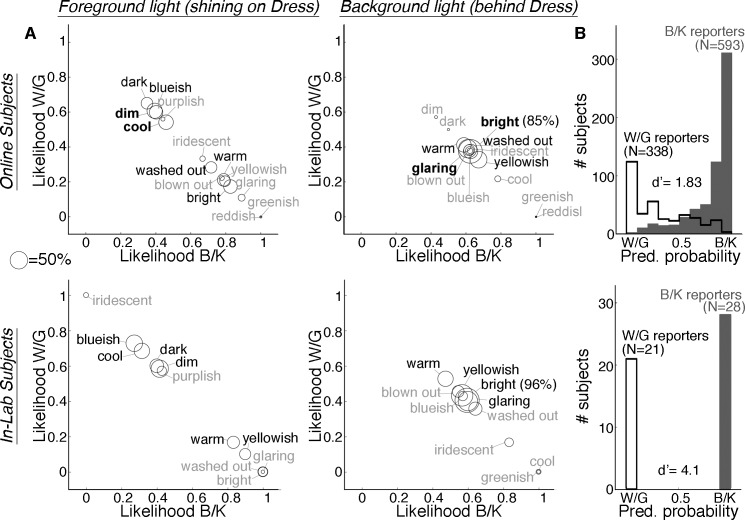Figure 12.
Subjects' color percepts of the dress are predicted by their inference of the lighting conditions. Subjects (top row: 1,074 online; bottom row: 49 in-lab; only subjects who reported either W/G or B/K are included in this analysis) were asked to characterize the light shining on the dress and the light illuminating the background, by checking off any of a number of possible verbal descriptors from a list (dim, dark, cool, blueish, bright, warm, yellowish, glaring, blown out, washed out, reddish, greenish, purplish, iridescent). (A) For each word in the list, the likelihood of being B/K = (# of B/K reporters who used the term)/(# of B/K + # of W/G who used the term). The diameter of the bubble reflects the proportion of people in the population who used the term: (# of B/K who used it + # of W/G who used it)/(# of B/K reporters + # of W/G reporters). Inset key = 50%. Bubble plots for the light shining on the dress (foreground; left panels) and the light in the background (right panels; top row: online subjects; bottom row: in-lab subjects). (B) Classification histograms for a binary logistic regression where the lighting descriptors were used as predictors to distinguish B/K from W/G reporters—online subjects: correct rate = 84% (85% for B/K, 80% for W/G), d′ = 1.83, R2 = 0.52; in-lab subjects: correct rate 100%, d′ = +∞, R2 = 1. A test of the full model against a constant-only model was statistically significant, indicating that the predictors (the verbal descriptors of the lighting conditions) as a set reliably distinguish between B/K reporters and W/G reporters (online subjects: X2 = 583, p < 0.001; in-lab subjects: X2 = 66.9, p = 0.037).

